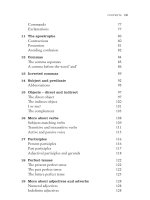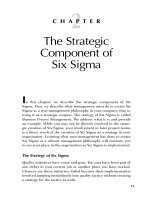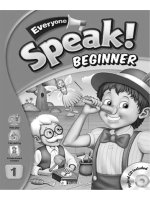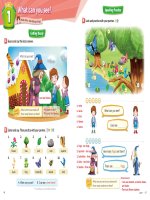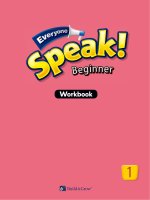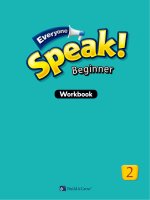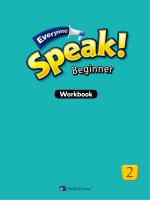Everyone speak 2 TG
Bạn đang xem bản rút gọn của tài liệu. Xem và tải ngay bản đầy đủ của tài liệu tại đây (6.96 MB, 40 trang )
1
C
e rs
onv
a ti o n
My Favorite Subject
Talking about your favorite subject
Theme
Core Language
• Names of school subjects
• What’s your favorite subject?
• My favorite subject is art.
• I like to speak English.
• I’m good at painting.
• Pronunciation
School life
Speaking Task
Talking about your
favorite subject
Speaking Skill
Short response
Words: survey experiment instrument participate
Sentence: My favorite subject is math.
Pacing Guide
Week 1:
Unit 1 My Favorite Subject
Section & Page
CD Track
Word Test
Time
8 mins.
Getting Ready
SB p.6
Speaking Practice
SB p.7
2
9 mins.
Conversation
SB p.8
3,4
9 mins.
Communication Task
SB p.9
Workbook
WB pp.2~3
Assign homework
7 mins.
9 mins.
2
3 mins.
Hybrid CD
Total Time
Unit 1
45 mins.
1
Introduction
B. Listen
Ask the students what their
favorite subjects are. Why
do they like the subjects?
Write down the reasons on
the board. Are there any
subjects they don’t like? Why
don’t they like the subjects?
Introduce the key vocabulary
(different school subjects)
and phrases for the unit
and practice saying them
together as a class.
Sarah: Your bedroom is
awesome, Andy.
Andy: Thanks, Sarah.
Sarah: You have a lot of cool
stuff in here. Wow, you
have a dinosaur action
figure and a microscope.
Andy: Well, science is my
favorite subject. I’m good
at doing experiments.
Sarah: I think science is really
hard. If I have trouble with
my science homework, can
I ask you for help?
Andy: Of course!
Sarah: Why don’t you have
any musical instruments in
your room?
Andy: I don’t like music.
I’m not good at playing
musical instruments.
Sarah: Really? Music is my
favorite subject. I like
to sing and I’m good at
playing the piano.
Andy: Oh, that’s great! You
can help me with my
music homework.
Sarah: I’d love to. We can help
each other!
Getting Ready
A. – Have the students look at the pictures. Read the sentences in the box together and explain any
2
new vocabulary to the students.
– Tell the students to match the subjects and sentences to the pictures. Explain that they should
write the letter for each subject in the first box and the letter for each sentence in the second
box.
– Check the answers together as a class. Encourage the students to speak in full sentences.
(Teacher: “What’s your favorite subject?” Students: “My favorite subject is art.” Teacher: “Why do
you like it?” Students: “I feel happy when I draw pictures.”)
Extra Idea – Have a spelling race with the subject names. Split the students into two teams. Have
the first student on each team stand at the back of the classroom. When you call out a school
subject they have to run to the board, write it down, and say “My favorite subject is ...” Whoever
does this first wins one point for their team. Give the team with the most points at the end of the
game a small reward.
B. Pair work – Ask the students to work in pairs. Have them practice the dialogue using the words
and sentences from activity A.
T2
Speaking Practice
A. – Have the students look at the picture, and ask them which bedroom they like better. Why do
they like it? Read over the list of objects in the bedrooms together as a class. Do the students
have any of these things in their bedrooms?
– Ask the students to work in pairs to answer the questions. Tell them to take turns asking and
answering the questions.
B. Listen – Tell the students that they are going to listen to a conversation between Sarah and Andy.
Play the recording and ask them to fill in the chart.
Extra Idea – Describe other bedrooms to the students and ask them to guess what the bedroom
owner’s favorite subject is and what they are good at. Choose some of the students to be the
“teacher” and have them try describing some bedrooms.
Talk It Over – Ask the students to work in pairs and talk about what their favorite subjects are and
why they like them.
3
Conversation
A. – Tell the students that they are going to practice talking about their favorite subjects.
– Let the students listen to the recording. Then ask them to read the conversation aloud.
– Review the information on the speaking cards and explain any new vocabulary to the students.
– Ask the students to work in pairs to practice the conversation. Have them take turns being A and
B so that they can practice using all of the vocabulary and expressions.
Extra Idea – Have a few students practice the dialogue in front of the class. Instead of using the
Communication Task
A. – Have the students look at the first chart. Ask them to check all of the subjects that they like.
B. – Ask the students “Who likes art?” Have one student count how many hands are raised. (Teacher:
“How many students in our class like art?” Student: “Three students in our class like art.”) Tell the
students to color in the number on the graph. After this has been done for all the subjects, ask
the students what the most popular subject is.
information from the textbook, ask them to describe their favorite subject using their own
reasons or the reasons that were written on the board during the introduction portion of the
lesson.
B. Pronunciation
– Play the recording. Have the students practice saying the words and the sentence.
4
5
Workbook Answers
A
1. cultures
2
My Favorite Teacher
Giving a speech about your favorite teacher
P r e s e n t a ti o n
2. dinosaurs
3. social studies
4. P. E.
5. add
6. survey
B
Theme
Core Language
School life
Speaking Task
Giving a speech about your
favorite teacher
1. b
Speaking Skill
2. c
Long response /
Impromptu speech
3. c
• My favorite teacher is Mr. Pluss.
• He’s my math teacher.
• He’s very kind.
• His lessons are interesting and fun.
• I want to learn more about math with Mr. Pluss.
• Pronunciation
Words: advice score patient generous
Sentence: When I had some problems with my
best friend, he gave me good advice.
4. a
5. c
6. a
C
Pacing Guide
b
a
c
D
Week 2:
Unit 2 My Favorite Teacher
Section & Page
d
Review &
Check homework
1 bedroom
Getting Ready
SB p.10
Presentation Practice
SB p.11
2 microscope
3 science
4 doing experiments
CD Track
Word Test
Presentation Workshop
Time
8 mins.
SB pp.12~13
7 mins.
5
9 mins.
18 mins.
5 my science homework
Workbook
6 musical instruments
7 playing musical instruments
8 playing the piano
9 my music homework
WB pp.4~5
Assign homework
3 mins.
Hybrid CD
Total Time
Unit 2
45 mins.
10 help each other
6
7
Introduction
Ask the students who their
favorite teachers are. What
subjects do the teachers
teach? Why do they like the
teachers?
Getting Ready
A. – Have the students look at the pictures. Read the phrases under the pictures together and explain
any new vocabulary to the students.
– Tell the students to match each teacher with the phrases that they think best describes the
person.
– When they have finished, ask the students to work in pairs and to talk about what phrases they
chose for each teacher.
Extra Idea
– Ask a few students to come to the front of the class and present one of the teachers using the
phrases they chose. Remind them to turn the phrases into full sentences when speaking.
Presentation Practice
A. – Before playing the recording, have the students look at the picture. What subject do they think
the man teaches? What kind of personality does he have? What are his lessons like?
– Tell the students to listen to the recording and fill in the blanks with the correct information.
– Check the answers together as a class, and then have the students read the presentation aloud.
B. – Ask the students to work in pairs to answer the questions about the presentation.
– Tell them to each ask one of the questions and their partner will say the answer.
Extra Idea
– Ask the students what special memories they have of you, and what they think of your lessons.
Write their ideas on the board (you can add your own funny answers if you’d like). Then have
them answer the questions in Activity B using the answers on the board.
Speaking Skill
– Write the speaking points on the board. Explain what information the students should include in
their presentations.
8
9
Presentation Workshop
The goal of this exercise is to help students organize their presentations using their own ideas.
Step 1:
– Read over the questions together as a class and quickly review the key vocabulary and
expressions that the students have practiced in Units 1 and 2.
– Introduce the language in the Idea Box on page 13 and tell the students that they can use these
ideas, along with their own ideas, for their answers if they want to.
– Tell the students to answer the questions on page 12 on their own. Quickly check over each
student’s answers after they have completed the exercise.
Step 2:
– Ask the students to fill in the blanks of their speech using their answers from page 12.
– After you have checked their work, ask them to fill in their presentation card for the unit.
Presentation Card
– A presentation card for each of the presentation units can be found at the back of the textbook.
Draw a presentation card on the board and show what kind of information can be written on
the presentation card. Explain to the students that they can write main points/ideas on the
presentation card, but remind them not to write their whole speech.
– Give a sample speech with the presentation card to demonstrate how it should be used. Show
the students that they should be looking at the audience when they speak, but can glance down
at the presentation card when they need to.
Presentation to others
– Using their presentation card, have the students give their speech in front of the class. If there
isn’t enough time for this, have the students work in groups and take turns presenting to one
another. Encourage the students listening to ask each speaker a follow–up question about the
information that has been presented.
Tip!
10
– Explain the presentation tip to the students. Demonstrate good and bad examples of the
presentation tip to show the students why it is good to follow the advice.
11
3
Workbook Answers
A
1. score
C
e rs
onv
a ti o n
At a Restaurant
Ordering food at a restaurant
2. mad
3. advice
4. special
5. safety
6. patient
Theme
Core Language
• May I take your order?
• I’ll have a ham sandwich.
• Would you like something to drink?
• I’d like a Coke.
• Pronunciation
Food
Speaking Task
7. low
Ordering food at a
restaurant
8. forget
Speaking Skill
Words: sandwich orange dessert appetizer
Sentence: I’ll have cream pasta and a Coke, please.
Short response
B
1. a
2. e
3. c
Pacing Guide
4. d
5. b
C
1. My favorite teacher is Mr. Hanks.
He’s my history teacher.
2. He’s always patient and kind.
3. When I forgot my homework, he didn’t get mad at me.
4. His lessons are fun and interesting.
5. I always get high scores on my history tests.
D
1 my science teacher
2 always kind and nice to everyone
Week 3:
Unit 3 At a Restaurant
Review &
Check homework
5 lessons are always interesting and fun
6 my science tests because of his great teaching
7 learn more about science with Mr. Beaker.
12
CD Track
Word Test
Time
8 mins.
Getting Ready
SB p.14
Speaking Practice
SB p.15
6
9 mins.
Conversation
SB p.16
7,8
9 mins.
Communication Task
SB p.17
3 he didn’t get mad at me
4 just worried about my safety
Section & Page
Workbook
WB pp.6~7
Assign homework
7 mins.
9 mins.
6
3 mins.
Hybrid CD
Total Time
Unit 3
45 mins.
13
Introduction
B. Listen
Ask the students what their
favorite restaurants are.
What do they like to order
to eat and drink when they
go to a restaurant? Do they
often order an appetizer
or dessert? Write down the
foods and drinks they say on
the board. Introduce the key
vocabulary and expressions
for the unit and practice
saying them together as a
class.
Waiter: Hi, I’m Liam. I’ll be
your server tonight. Are
you ready to order?
Customer 1: Yes, we are. I’d
like a pizza and a bottle of
water.
Waiter: What kind of pizza
would you like?
Customer 1: I’d like the
veggie supreme pizza.
Waiter: Good choice! How
about you? What would
you like to eat?
Customer 2: I’d like a burger.
Waiter: What kind of burger
would you like?
Customer 2: What do you
recommend, the double
cheeseburger or the
bacon cheeseburger?
Waiter: Both are good,
but I prefer the double
cheeseburger.
Customer 2: Okay, I’d like the
double cheeseburger and
a Coke, please.
Waiter: Great. I’ll take your
menus and your food will
be ready in a few minutes.
Getting Ready
A. – Have the students look at the menu. Do they think they would like eating at the Wonderful
14
Restaurant? Read over the menu sections and the list of foods together.
– Tell the students to match the names of the foods to the pictures.
– Check the answers together as a class.
Extra Idea – Tell the students “I’m hungry. I want a double cheeseburger.” Ask a student to repeat
what you said and to add a food item, “I’m hungry. I want a double cheeseburger and fried
chicken.” The next student should repeat the first two items and add a third item. If a student
can’t remember the full list of food items, they are out of the game. Keep playing until you have
a winner (or a few winners).
B. Pair work – Ask the students to work in pairs. Have them practice the dialogue using the
vocabulary from the menu in activity A.
Extra Idea – Do a restaurant role play with several of the students. Ask “How many people are in
your group?” and then lead them to chairs at the front of the class and take their orders. You
can tell your “customers” about the daily specials, offer recommendations, and apologize if
something is sold out. If you want, you can even give them a bill and ask who will be paying!
After, quiz the other students about what everyone ordered.
T6
Speaking Practice
A. – Have the students look at the menu. What toppings do they like on their burgers and pizza?
– Ask the students to work in pairs. Tell them to check what they would like to eat and drink on the
menu and to practice ordering them with their partner.
B. Listen – Tell the students that they are going to listen to two customers ordering food from the
menu in Activity A. Ask them to write down what each customer orders.
Extra Idea – Before playing the recording, ask the students what they think the customers will order.
Give any students who guess both customers’ orders correctly a small reward.
Talk It Over – Ask the students to work in pairs and talk about what they want to have for lunch.
After, have the students tell the class what their partner wants to eat. (Student A: “Lisa wants to
have lasagna for lunch.” Student B: “Mika wants kimchi and rice for lunch.”)
Extra Idea – Talk about the different foods that the students want to have for lunch together as
a class. Do the other students like that food? Why or why not? (Teacher: “Lisa wants to have
lasagna for lunch. Do you like lasagna?” Students: “Yes, I do./ No, I don’t.”)
15
Conversation
A. – Tell the students that they are going to practice ordering food.
– Let the students listen to the recording. Then ask them to read the conversation aloud.
– Review the information on the speaking cards and explain any new vocabulary to the students.
– Ask the students to work in pairs to practice the conversation. Have them take turns being A and
B so that they can practice using all of the vocabulary and expressions.
B. Pronunciation
– Play the recording. Have the students practice saying the words and the sentence.
16
Communication Task
A. – Have the students look at the menu. Tell them to check the items that they want to order for
dinner.
B. – Ask the students to work in pairs. Tell them to take turns being a server and a customer at
Fantastic Restaurant. The server will write down the customer’s order in the chart.
C. – Ask the students to use the information from the chart to fill in the blanks in the box. Have the
pair stand up and tell the class what their partner wants to order for dinner.
Extra Idea – Ask the students to think of more items for each section of the menu. Write their ideas
down, along with the menu items in the textbook, on small slips of paper. Put all of the pieces
of paper in an envelope or a box. Have each student come up to the front of the classroom and
pull out four slips of paper. The first one will be their appetizer, the second their main dish, the
third their drink, and the fourth their dessert. Write the meal combinations on the board and ask
the other students if they’d like to order it. Encourage the students to laugh at the strange meals
that get created. (“I’ll have a pizza for my appetizer. I’ll have a cookie for my main dish. I’ll have
soup for my drink, and a Coke for dessert.”)
17
Workbook Answers
A
1. fried
4
My Favorite Fruit
Giving a speech about your favorite fruit
P r e s e n t a ti o n
2. pasta
3. ordered
4. mayonnaise
5. pie
6. extra
B
1. a
2. a
Theme
Core Language
• Papayas are my favorite fruit.
• Papayas are not so big and look like melons.
• Strawberries are bright red.
• They have small green leaves on top.
• Strawberries smell like sweet flowers and taste
Food
Speaking Task
Giving a speech about
your favorite fruit
sweet and sour.
• I like to eat strawberries after dinner.
• I like strawberries because they’re easy to eat and
full of vitamins.
• Pronunciation
Words: tangerine watermelon vitamin bitter
Sentence: Papayas are not so big and look like
melons.
Speaking Skill
Long response /
Impromptu speech
3. b
4. c
5. c
6. b
C
d
b
a
D
Pacing Guide
c
1 server
2 ready to order
3 a bottle of water
Week 4:
Unit 4 My Favorite Fruit
Review &
Check homework
Section & Page
CD Track
Word Test
Time
8 mins.
Getting Ready
SB p.18
Presentation Practice
SB p.19
7 mins.
9
9 mins.
4 like to eat
5 a burger
Presentation Workshop
6 recommend
7 prefer
8 take your menus
9 be ready
18
SB pp.20~21
Workbook
18 mins.
WB pp.8~9
Assign homework
3 mins.
Hybrid CD
Total Time
Unit 4
45 mins.
19
Introduction
Ask the students about their
favorite fruits. What do they
look like? Why do they like
them? When do they like to
eat them?
Getting Ready
A. – Ask the students to look at the pictures. Which fruit do they prefer?
– Read the chart and the words and phrases from the box together and ask the students to work
on their own to fill in the chart.
– Check the answers together as a class.
Extra Idea
– Choose some other fruits for the students to describe using the chart.
Presentation Practice
A. – Before playing the recording, have the students describe the fruits in the picture. What are they
called? What do they look like? Have they ever tried them?
– Tell the students to listen to the recording and fill in the blanks with the correct information.
– Check the answers together as a class, and then have the students read the presentation aloud.
B. – Ask the students to work in pairs to answer the questions about the presentation.
– Tell them to each ask one of the questions and their partner will say the answer.
Extra Idea
– Tell the students to describe different fruits using the model presentation in Activity A. Their
partner will try to guess what fruits they are.
Speaking Skill
– Write the speaking points on the board. Explain what information the students should include in
their presentations.
20
21
Presentation Workshop
Step 1:
– Read over the questions together as a class and quickly review the key vocabulary and
expressions that the students have practiced in Units 3 and 4.
– Introduce the language in the Idea Box on page 21 and tell the students that they can use these
ideas, along with their own ideas, for their answers if they want to.
– Tell the students to answer the questions on page 20 on their own. Quickly check over each
student’s answers after they have completed the exercise.
Step 2:
Presentation to others
– Using their presentation card, have the students give their speech in front of the class. If there
isn’t enough time for this, have the students work in groups and take turns presenting to one
another. Encourage the students listening to ask each speaker a follow-up question about the
information that has been presented.
Tip!
– Explain the presentation tip to the students. Demonstrate good and bad examples of the
presentation tip to show the students why it is good to follow the advice.
– Ask the students to fill in the blanks of their speech using their answers from page 20.
– After you have checked their work, ask them to fill in their presentation card for the unit.
22
23
5
Workbook Answers
A
1. bright
C
e rs
onv
a ti o n
Can I Have a Ticket?
Buying tickets
2. sour
3. bitter
4. vitamins
5. full of
6. healthy
7. watermelon
8. sweet
B
Theme
Core Language
• I’d like three tickets for Shrek. How much are they?
• It’s 10 for each. So the total price is 30.
• Do you give special discounts for students?
• Students get 20% off their tickets.
• Here are your tickets.
• Pronunciation
Movies
Speaking Task
Buying tickets
Speaking Skill
Short response
Words: theater museum concert
Sentence: How much are they?
1. b
amusement
2. c
3. d
Pacing Guide
4. a
5. e
C
1. Apples are my favorite fruit.
2. Apples are red and look like balls.
3. Apples smell like fresh flowers and taste sweet and sour.
4. I like to eat apples for breakfast.
5. I like apples because they are crispy, delicious, and healthy.
D
1 tell you about my favorite fruit
2 small and look like little hearts
3 have small seeds on the outside
Week 5:
Unit 5 Can I Have a Ticket?
Review &
Check homework
6 like to eat strawberries after dinner
7 easy to eat and full of vitamins
24
CD Track
Word Test
Time
8 mins.
Getting Ready
SB p.22
Speaking Practice
SB p.23
10
9 mins.
Conversation
SB p.24
11,12
9 mins.
Communication Task
SB p.25
4 have small green leaves on top
5 flowers and taste sweet and sour
Section & Page
Workbook
WB pp.10~11
Assign homework
7 mins.
9 mins.
10
3 mins.
Hybrid CD
Total Time
Unit 5
45 mins.
25
Introduction
B. Listen
Ask the students about
places they can go with their
friends and family to have
fun. How much money does
it cost to visit these places?
Do they need to buy a ticket
to go there? Introduce the
key vocabulary (different
attractions, money) and
expressions (I’d like tickets
for (place). / How much are
they? / Do you give special
discounts for students?) for
the unit and practice saying
them together as a class.
W: May I help you?
B: Can I have two tickets
for tonight’s hip–hop
concert?
W: Sure. Tickets in the front
are 20 each. Tickets in
the middle are 10. And
tickets in the back are 5.
B: Can we have two tickets in
the front, please?
W: Sure. We also have a
student discount. Are
both of you students?
B: Yes, we are. Here are our
student IDs.
W: Terrific. Students get
a 10% discount on all
tickets, so the total price is
36.
B: That’s great. Thanks for all
your help.
W: It’s my pleasure. Here are
your tickets. Enjoy the
concert.
Getting Ready
A. – Have the students look at the pictures. Read the names of the places together.
– Tell the students to fill in the blanks in the chart.
– Check the answers together as a class.
B. – Read the sentences together. Ask the students to match the sentences in the box with the other
sentences.
– Check the answers together as a class.
Extra Idea
– Teach the students how to talk about money. Tell them the names of the different American
coins (and show them examples of each coin if you have them). Read off a list of 10 prices and
have the students write them down. (Teacher: “How much is it?” “It’s 11.75.” / “It’s a quarter.” / “It’s
100.”
26
T10
Speaking Practice
A. – Have the students look at the pictures and read the kinds of concerts together. Have the
students ever watched a concert? What kind of concert was it? Why did they like it?
– Ask the students to work in pairs. Tell them to check the kind of concert they want to go to and
to talk about it with their partner.
B. – Read the questions together and then tell the students to listen to the boy buying concert
tickets. Ask them to circle the correct answers.
Talk It Over
– Have the students ask you about a concert you want to go to.
Extra Idea
– Tell the students a different genre of music than the ones listed in Activity A. If the students
don’t know how to spell the musical style, have them ask “How do I spell that?” Spell the word
really quickly a few times so that they have to ask “How do I spell that?” again.
27
Conversation
A. – Tell the students that they are going to practice buying tickets for an event.
– Let the students listen to the recording. Then ask them to read the conversation aloud.
– Review the information on the speaking cards and explain any new vocabulary to the students.
– Ask the students to work in pairs to practice the conversation. Have them take turns being A and
B so that they can practice using all of the vocabulary and expressions.
Extra Idea
– Have the students make money and use it to buy their tickets. They can also use their money in
the Communication Task on page 25.
Communication Task
A. – Have the students look at the chart. Tell them to write how many tickets they want for each
event. Ask them to buy tickets for adults and children.
– Ask the students to work in pairs. Tell them to take turns buying and selling tickets for the
different events listed in Activity A. Remind them that they should use “the” before “dolphin
show,” “pop concert,” and “art exhibition,” but they shouldn’t use “the” before “today’s movie.”
B. – After their partner has finished buying tickets for each event in Activity A, tell the students to
make receipts for them.
B. Pronunciation
– Play the recording. Have the students practice saying the words and the sentence.
28
29
Workbook Answers
A
1. movie theater
6
My Favorite Movie
Giving a speech about your favorite movie
P r e s e n t a ti o n
2. ballpark
3. recently
4. concert
5. tickets
6. exhibition
B
Theme
Core Language
Movies
Speaking Task
Giving a speech about your
favorite movie
1. a
Speaking Skill
2. b
Long response /
Impromptu speech
3. b
• My favorite movie is Kung Fu Panda.
• It’s an animated movie.
• The movie is about a panda bear named Po.
• My favorite character in the movie is Po.
• I like this movie because the computer
animation is great.
• Pronunciation
Words: kidnap rescue effect horror
Sentence: The movie is about a young woman’s
adventure.
4. c
5. a
6. c
C
d
a
c
D
Pacing Guide
b
1 two tickets
2 $20
3 in the middle
4 in the back
5 in the front
Week 6:
Unit 6 My Favorite Movie
Review &
Check homework
8 the total price
9 my pleasure
10 Enjoy the concert
30
CD Track
Word Test
SB p.26
Presentation Practice
SB p.27
Presentation Workshop
SB pp.28~29
Workbook
Time
8 mins.
Getting Ready
6 student discount
7 discount
Section & Page
7 mins.
13
9 mins.
18 mins.
WB pp.12~13
Assign homework
3 mins.
Hybrid CD
Total Time
Unit 6
45 mins.
31
Introduction
Ask the students how often
they watch movies. Do they
watch movies at home or
at a movie theater? If the
students go to a movie
theater, who do they go
with? Who buys the tickets?
Extra Idea
Role play buying tickets
for a movie with some of
the students to review the
language from Unit 5.
Getting Ready
A. – Have the students look at the movie posters.
– Read the movie genres in the box together and tell the students to write the correct kind of
movie under each poster.
– Check the answers together as a class. Encourage the students to speak in full sentences.
(Teacher: “What kind of movie is Home Alone?” Students: “Home Alone is a comedy.”)
B. – Which of the movies from Activity A would the students like to watch? Why do they want to
watch them? Write their reasons on the board.
– Ask the students to work in pairs. Have them talk about what kinds of movies they like the best
with their partners. They can use their own reasons, or the reasons that are written on the board.
Presentation Practice
A. – Before playing the recording, have the students describe what they see in the picture. Ask them
to guess what Jennifer’s favorite movie is.
– Tell the students to listen to the recording and fill in the blanks with the correct information.
– Check the answers together as a class, and then have the students read the presentation aloud.
B. – Ask the students to work in pairs to answer the questions about the presentation.
– Tell them to each ask one of the questions and their partner will say the answer.
Extra Idea
– Have the students answer the questions a second time with information about their favorite
movie. Ask them to tell their partner what the movie is about and why they like the movie, but
not to say the name of the movie. After hearing their answers, their partner can try to guess
what the movie is.
Speaking Skill
32
– Write the speaking points on the board. Explain what information the students should include in
their presentations.
33
Presentation Workshop
Step 1:
– Read over the questions together as a class and quickly review the key vocabulary and
expressions that the students have practiced in Units 5 and 6.
– Introduce the language in the Idea Box on page 29 and tell the students that they can use these
ideas, along with their own ideas, for their answers if they want to.
– Tell the students to answer the questions on page 28 on their own. Quickly check over each
student’s answers after they have completed the exercise.
Step 2:
Presentation to others
– Using their presentation card, have the students give their speech in front of the class. If there
isn’t enough time for this, have the students work in groups and take turns presenting to one
another. Encourage the students listening to ask each speaker a follow-up question about the
information that has been presented.
Tip!
– Explain the presentation tip to the students. Demonstrate good and bad examples of the
presentation tip to show the students why it is good to follow the advice.
– Ask the students to fill in the blanks of their speech using their answers from page 28.
– After you have checked their work, ask them to fill in their presentation card for the unit.
34
35
7
Workbook Answers
A
1. recommend
C
e rs
onv
a ti o n
In My Free Time
Talking about your free time activities
2. animated
3. effects
4. horror
5. thrilling
6. rescue
Theme
Core Language
• What do you do in your free time?
• I like to jump rope.
• I usually play tennis.
• Where do you go swimming?
• I go swimming at the beach.
• Who do you go with?
• I go with my friends.
• Pronunciation
Free time activities
Speaking Task
7. heartwarming
Talking about your
free time activities
8. kidnapped
Speaking Skill
Short response
B
Words: computer beach volunteer skateboard
Sentence: I usually go swimming.
1. d
2. c
3. a
4. e
Pacing Guide
5. b
C
1. My favorite movie is Hachiko: A Dog’s Story.
2. It’s a drama.
3. The movie is about a dog named Hachiko. He waits for the return
of his dead owner.
Week 7:
Unit 7 In My Free Time
Review &
Check homework
Section & Page
CD Track
Word Test
Time
8 mins.
Getting Ready
SB p.30
7 mins.
Speaking Practice
SB p.31
14
9 mins.
Conversation
SB p.32
15,16
9 mins.
Communication Task
SB p.33
4. My favorite character in the movie is Hachiko.
5. He’s smart and loyal to his owner.
6. I like this movie because it’s sad but heartwarming.
D
1 a panda bear named Po
2 his dream come true
3 make my dream come true just like him
4 the computer animation is great
Workbook
WB pp.14~15
Assign homework
9 mins.
14
3 mins.
Hybrid CD
Unit 7
5 recommend that you watch it
Total Time
36
45 mins.
37
Introduction
B. Listen
Ask the students what they
like to do in their free time.
Where do they do it? Who
do they do it with? Write the
free time activities they say
on the board. Introduce the
key vocabulary (free time
activities) and expressions
(What do you do in your free
time? / Where do you do it?
/ Who do you do it with?) for
the unit and practice saying
them together as a class.
Kate: I’m so happy that
school is finished.
Mike: Me too! Do you want
to walk home together?
Kate: Sure. What are your
plans for the rest of the
day, Mike?
Mike: I’m just going to watch
TV at home.
Kate: Is that what you usually
do in your free time?
Mike: No, I usually play
computer games and I
sometimes build models.
How about you, Kate?
Kate: I always go to the gym
and practice kendo.
Mike: Is kendo fun?
Kate: Yes, it is. Why don’t you
come to the gym with
me? I’ll teach you how to
do it.
Mike: No, thanks. I don’t
like sports very much. I’d
rather stay at home.
Getting Ready
A. – Have the students look at the pictures. Read the phrases in the box together as a class.
– Tell the students to match the correct phrase to each picture.
– Check the answers together as a class. Encourage the students to answer in full sentences.
(Teacher: “What do you like to do in your free time?” Students: “I like to ...”)
Extra Idea
– Play charades. Whisper one of the free time activities to a student. The rest of the class will ask
“What do you like to do in your free time?” The student will aswer “I like to” and then do the
action. Whoever guesses the free time activity first (“You like to jump rope”) gets to be the next
person to perform an action. Have the students act out some of the activities written on the
board during the introduction in addition to the ones in Activity A.
B. Pair work – Ask the students to work in pairs. Have them practice the dialogue using the
vocabulary from activity A.
38
T14
Speaking Practice
A. – Have the students look at the pictures and read the names of the free time activities together.
Do the students do any of these free time activities?
– Ask the students to work in pairs. Tell them to check the activities that they like to do (or would
like to try if they don’t do any of the activities).
Extra Idea
– Make flashcards with the activities from Activity A and page 30. Use magnets to put some of the
flashcards on the board. Have the students say the activities on the flashcards. (Teacher: “What
do you do in your free time?” Students: “I usually ...”) Tell the students to close their eyes. Move
the flashcards around and take one away. Tell the students to open their eyes and ask them
which flashcard is missing. (See the worksheet on page 43~46.)
B. – Tell the students that they are going to listen to Kate and Mike talk about their free time
activities. Ask them to write down the activities that Kate and Mike do in their free time.
39
Conversation
A. – Tell the students that they are going to practice talking about free time activities.
– Let the students listen to the recording. Then ask them to read the conversation aloud.
– Review the information on the speaking cards and explain any new vocabulary to the students.
– Ask the students to work in pairs to practice the conversation. Have them take turns being A and
B so that they can practice using all of the vocabulary and expressions.
Extra Idea
– Have a few students practice the dialogue in front of the class. Instead of using the information
from the textbook, ask them to talk about the free time activities they like to do.
Communication Task
A. – Read the words and phrases in the boxes together. Ask the students to write three free time
activities in the chart. Tell them to also include information about where they do the activity,
how often they do it, and whom they do it with. Students can use the information in the boxes
to do this, or their own ideas. Make sure the students don’t tell anyone which free time activities
they chose.
B. – Ask the students to work in pairs. Their partner will ask them questions to try and guess the free
time activities they have written down.
B. Pronunciation
– Play the recording. Have the students practice saying the words and the sentence.
40
41
Workbook Answers
A
Flashcards
1. free time
2. rest
3. musical instruments
4. chat
5. often
6. voluteer
B
1. a
2. c
3. c
4. b
5. a
6. c
C
d
b
a
c
D
1 happy
2 walk home
3 your plans
4 watch TV
5 free time
6 play computer games
7 build models
8 practice kendo
9 how to do it
10 stay at home
42
43
44
45
8
Extreme Sports
Giving a speech about extreme sports
P r e s e n t a ti o n
Theme
Core Language
• If I join the Extreme Sports Club, I want to learn
Free time activities
how to snowboard.
• I love winter and playing in the snow.
• I saw people snowboarding on TV and it looked
like a lot of fun!
• I want to surf on top of a big wave in the ocean.
• It will be exciting to do cool tricks on a surfboard.
• To surf, all I need is a wetsuit and a surfboard.
• I think surfing is the perfect extreme sport for me!
• Pronunciation
Words: surfboard wetsuit trick wave
Sentence: If I join the Extreme Sports Club, I want
to learn how to snowboard.
Speaking Task
Giving a speech about
extreme sports
Speaking Skill
Long response /
Impromptu speech
Pacing Guide
Week 8:
Unit 8 Extreme Sports
Review &
Check homework
Section & Page
Word Test
SB p.34
Presentation Practice
SB p.35
SB pp.36~37
Workbook
Time
8 mins.
Getting Ready
Presentation Workshop
7 mins.
17
9 mins.
18 mins.
WB pp.16~17
Assign homework
3 mins.
Hybrid CD
Total Time
46
CD Track
Unit 8
45 mins.
47
